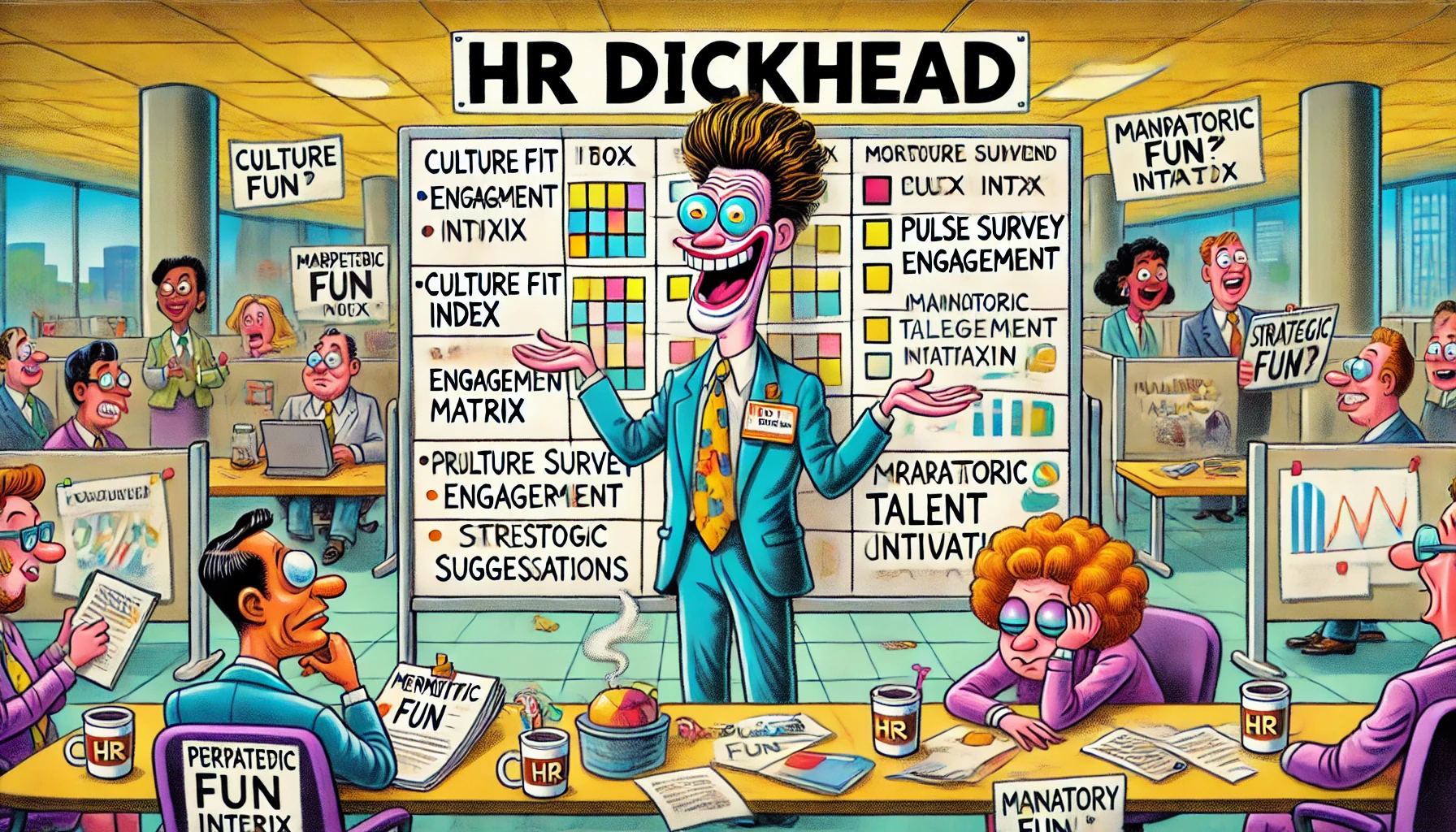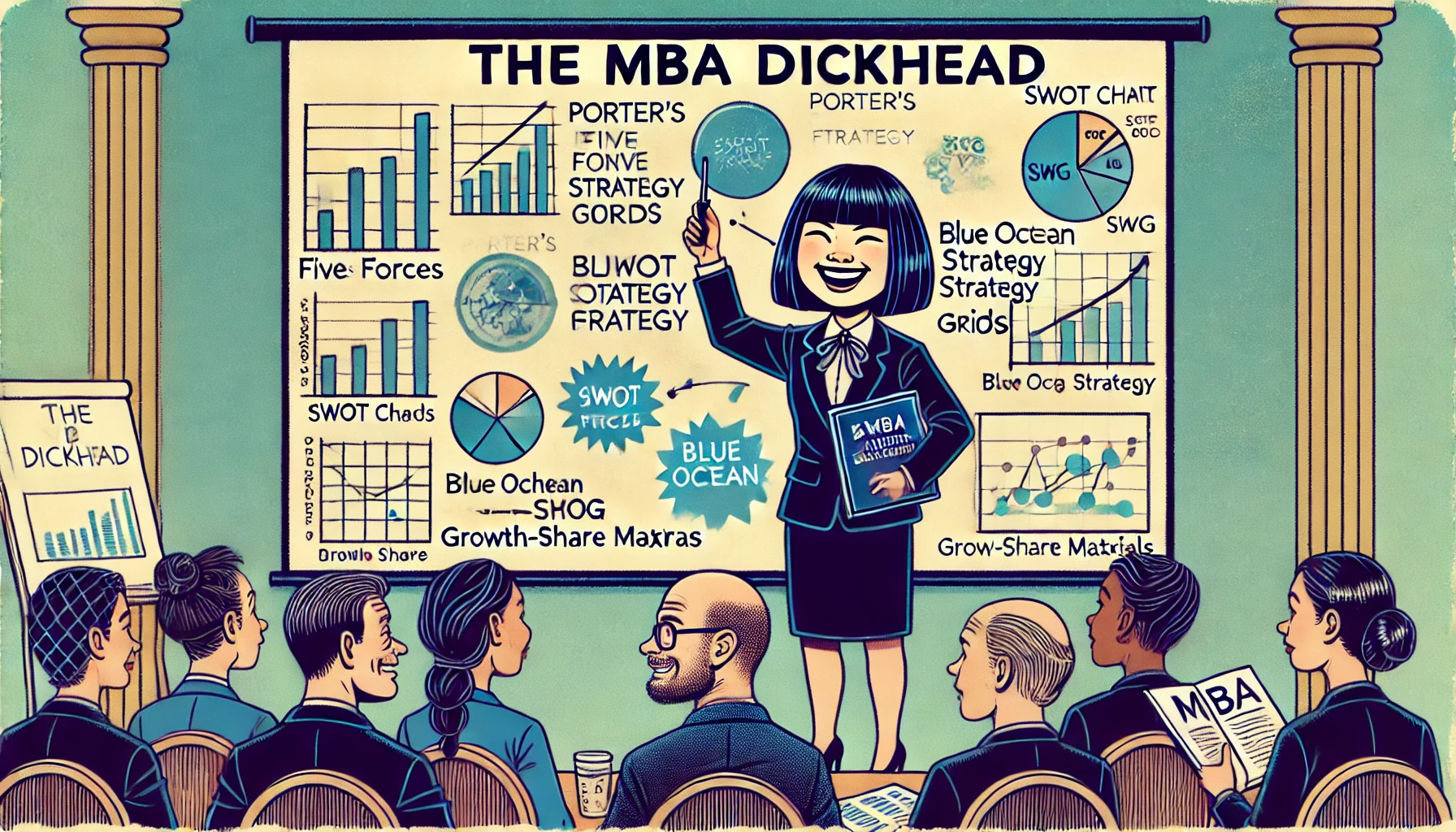Definition: The 9-Box Grid Tyrant of Culture and Process
Meet the HR Dickhead – the ultimate gatekeeper of corporate nonsense. This is the person who treats HR as a holy order of bureaucracy, guarding the gates with policy manuals and PowerPoints. In theory, HR is about helping humans; in practice, our HR Dickhead obsesses over the latest 9-box grid talent rankings, culture fit checklists, and endless assessments that magically quantify “potential” on a spreadsheet. They’re less about people and more about process – if it can’t be measured in a survey or plotted in a chart, it doesn’t count. Their mantra: why solve a simple problem with common sense when you can use a 12-step framework instead?
The HR Dickhead is the self-appointed referee of the workplace. They insist that every hire passes the vibe test of “fit” (an undefinable metric they wield like a gavel) and that every employee is squeezed into a competency model or a 9-box matrix. If you ever wondered who invented the quarterly 83-question “employee engagement” questionnaire – look no further. This character measures success not in output or happiness, but in how neatly everyone complies with arbitrary HR processes. Think of them as the bureaucratic black hole where real human issues disappear, only to be replaced by policy jargon and mandatory fun initiatives. In short, the HR Dickhead is obsessed with forms over function – the kind of person who would rather tick a box than actually solve a problem.
Parody Scenario: A Day in the Life of an HR Dickhead
Let’s peek into a day in the life of our HR Dickhead and the havoc they wreak:
9:00 AM – The Culture Fit Crusade: A hiring manager excitedly proposes a talented candidate who aced the interviews. Enter the HR Dickhead, clutching the candidate’s personality assessment results with a disapproving frown. “I have some concerns about cultural misalignment,” they declare. The candidate didn’t use enough corporate buzzwords and (gasp!) admitted they prefer flexible hours – clearly not a “culture fit.” The hiring decision is blocked over nebulous culture concerns, leaving the team bewildered. (Never mind that the team is drowning in work and desperately needs help – better unfilled than un-assessed by HR.) The HR Dickhead smugly notes that this protects the sacred company culture, as if they’ve just averted a national crisis.
11:00 AM – Pulse Survey Pandemonium: By mid-morning, our hero has a new mission: launching another pulse survey that no one asked for. An email hits everyone’s inbox: “Please complete this 20-question pulse survey by end of day to help improve our workplace!” The survey asks things like, “On a scale of 1-10, how valued do you feel?” (Employees know the real correct answer is whatever doesn’t trigger a follow-up meeting.) Everyone groans, knowing full well no one cares about the results – least of all HR, who will gleefully compile the data into a colorful chart and promptly ignore any real issues it reveals. But to the HR Dickhead, this charade of engagementis crucial work. They’ll boast about the 98% response rate (achieved only via relentless nagging) in the next staff meeting, congratulating themselves for “driving engagement,” while actual work was paused so people could fill this out. Productivity has derailed before lunch, all in service of another metric for HR to pat itself on the back.
3:00 PM – Succession Planning Circus: The afternoon brings the pièce de résistance: a succession planning workshop that swallows up the entire team’s time. The HR Dickhead corrals managers into a conference room (or yet another Zoom call) for an “urgent strategic session” on the future org chart. For hours, everyone is forced to discuss who might replace whom in hypothetical scenarios years down the line. (Because nothing fixes today’s problems like endless succession planning for tomorrow.) Whiteboards fill with names in little boxes, arrows pointing everywhere – a frenzy of perpetual reorganization ideas. Of course, this exercise conveniently uses the legendary 9-box grid: plotting each employee into one of nine categories of performance vs. potential, as if human careers can be tidily boxed up. By the time the meeting ends, real work has been thoroughly disrupted. The only tangible outcome is a grand org chart reorg proposal (that looks suspiciously like the current one, just with new buzzwords) and a spreadsheet of “talent assessments” that will be forgotten until the HR Dickhead resurrects it for the next cycle. But our HR Dickhead is beaming – this is their Super Bowl, and they’ve dominated the day with process over productivity.
By 5:00 PM, the HR Dickhead is satisfied that they’ve “added value” through these antics. They’ve blocked a hire in the name of culture, extracted a round of survey data to justify their role, and orchestrated a bureaucratic circus to showcase their strategic importance. Meanwhile, everyone else wonders what just happened and why getting actual work done felt like swimming in molasses.
Why They Exist: Architects of Organized Chaos
How does a person like this thrive? HR Dickheads exist because corporate culture lets them. They have convinced the higher-ups that HR is the architect of company performance – that every success stems from a well-aligned competency model and a perfectly executed performance review cycle. In their narrative, they aren’t paper-pushers; they’re strategistsshaping the workforce of the future. (They’ll happily tell you: “People are our greatest asset,” taking credit for the hard work of those very people.) By framing themselves as indispensable architects of culture and performance, they gain license to stick their noses into every part of the business. After all, if the company does well, it’s because their processes ensured the “right talent pipeline”; if it fails, clearly folks didn’t follow HR guidelines!
Another reason they thrive: job security through complexity. The HR Dickhead absolutely loves a perpetual reorganization. If things are running smoothly, that simply won’t do – time to shuffle the org chart or introduce a brand-new “initiative” so that chaos ensues and they remain relevant. They know that as long as they’re busy reinventing the performance review process or rolling out a new competency framework, no one can imagine letting them go – who else understands this convoluted stuff? It’s a classic move: create a mess that only you can clean up (and then never actually finish cleaning it). By championing constant change (for its own sake), they ensure the company always “needs” their guidance to navigate it.
Let’s not forget their bureaucratic grip on hiring and firing. This control is a power rush: they are the gatekeepers of who comes into the company and who must leave. Need to fire an obvious bad apple? Not without completing the 12-step performance improvement plan that the HR Dickhead insists on. Want to hire a rockstar candidate quickly? Sorry, the job requisition needs to go through seven layers of approval and a culture committee review first. This stranglehold means everyone has to play by the HR Dickhead’s rules – further cementing their power. They thrive in environments where questioning them is taboo; if you dare say “Is this policy really necessary?” you’ll be swiftly reminded that “that’s not how we do things here” and possibly sent to a remedial “culture alignment” workshop as penance.
In short, HR Dickheads survive and prosper by branding themselves as the strategic saviors of the company’s people, while actually entrenching themselves in layers of self-created bureaucracy. They’ve mastered the art of doing very little of real substance while making it look like they’re doing everything. It’s a sweet gig – if you can keep everyone else fooled.
How to Spot One: Red Flags and Signature Moves
Not sure if you’ve got an HR Dickhead on your hands? Look out for these telltale signs:
The Objectivity Charlatan: They trumpet the importance of “fair, objective processes,” but everything is based on subjective assessments. They’ll swear the promotion decision came from the calibrated performance data – meanwhile, you know it was actually because Bob plays golf with his manager. HR Dickheads live for elaborate performance rating scales and stack rankings that give the appearance of objectivity. (Pro tip: if someone insists that the 9-box grid is absolute science, you might have an HR Dickhead nearby.)
The Culture Fit Fanatic: “Culture” is their favorite word – specifically, how everyone else is a poor culture fit. They wield culture fit like a rubber stamp to approve or reject anything: new hire, project idea, even the choice of office snacks. Of course, their definition of culture is conveniently vague and ever-shifting. If you hear phrases like, “I’m not sure they align with our values of synergy and excellence,” paired with a concerned head tilt, you’ve spotted the species. They’re the ‘Culture Fit’ Gatekeeper, acting like the company’s bouncer with an exclusive vibe list.
Master of the Pay Review: This individual relishes being the master of pay review season. They treat the annual compensation review like the Olympics of HR. Expect lengthy calibration meetings where they insist on discussing the difference between a 3.4 and a 3.5 performance score because it affects a 0.5% raise differentiation. They derive a strange delight from being the final arbiter of who gets a raise (most likely no one beyond the budgeted peanuts). Any attempt to reward a high performer outside the normal cycle will be met with, “That wouldn’t be equitable.”They cloak subjective judgments in the language of fairness and equity – all while ensuring the process is as confusing as possible so they remain the all-knowing pay guru.
Addicted to HR Tech (and Other Fads): New HR system on the market? They want it. Yesterday. An HR Dickhead is perpetually shopping for the next big tool: a new performance management platform, a cutting-edge “AI-driven” recruitment system, or yet another module for the HRIS that promises to streamline workflows. They’ll spend six months implementing a new system (with mandatory training for everyone, of course) only to abandon it for the next shiny object in a year. They speak fluent vendor jargon and will excitedly demo the latest software that no one really needed, just to feel ahead of the curve. If someone is unnaturally excited about competency frameworks, online learning portals, or the newest 360-degree feedback tool – and they insist this will “transform our people strategy” – you’ve likely got an HR Dickhead in the building.
Jargon and Buzzword Overload: You’ll know you’ve met an HR Dickhead when your conversations feel like they’re in another language. They won’t say “training”; they’ll say “capability uplift initiative.” They never talk about employees, only “human capital.” And of course, rather than problems, there are “areas of opportunity”. In meetings, they keep referring to themselves and their peers as “strategic business partners” who are here to align “people strategy with business objectives.” It sounds impressive, but ask them for specifics and you’ll get a lot of corporate waffle. Essentially, if someone’s job title has the word “Strategy” but their calendar is filled with performance review deadlines, you might be dealing with an HR Dickhead who pretends to be a business strategist while actually just running the same old HR cycles that everyone dreads.
Spot a few of these signs? Congratulations (or rather, condolences) – you’ve identified the HR Dickhead in your midst. Now, how do you survive them?
How to Deal With Them: A Satirical Survival Guide
Dealing with an HR Dickhead is a delicate art. You can’t exactly ignore them (they run the processes you’re stuck with), and fighting them head-on can be like punching fog – frustrating and futile. Here’s your tongue-in-cheek survival guide to managing their impact:
Play Along (Just Enough): The HR Dickhead feeds on compliance. Sometimes the path of least resistance is to nod, smile, and fill out the form. Complete their mandatory trainings (double speed if possible), turn in the self-assessment they demand (with just enough corporate-speak to check the box), and move on. By giving them the minimum of what they want, you avoid raising red flags. Think of it as throwing a small treat to distract the guard dog. They get their sense of control; you get to return to real work relatively unbothered.
Don’t Get Caught in the Web: Avoid volunteering for any “HR-led initiative” like it’s the plague. The HR Dickhead loves to rope well-meaning employees into committees for culture, endless focus groups, or beta testing the new HR software. Steer clear unless you enjoy circular meetings about updating the dress code policy. The more you stay off their radar, the less likely you’ll be drafted into the next competency framework rollout taskforce. If you must participate, set boundaries: “I can contribute for one hour, then I have client work” – a subtle reminder that actual business work exists.
Document and Defend: If you anticipate an HR Dickhead roadblock (say you must hire someone urgently or resolve a team issue), come prepared with documentation and data. It’s ironic, but using their own love of paperwork against them can work. Have emails, performance reports, org charts – whatever ammo you need – ready to go. For example, if they stall your hiring with a “we need to evaluate the role,” whip out a report of how overworked the team is and how many goals are at risk. If they demand a performance improvement plan for an obvious problem employee, show them you’ve already done four coaching sessions and training. Beat them at their own game: bureaucracy. It’s not fun, but it can press them to relent faster when they see you’ve mastered the process playbook as well as they have.
Speak Their Language (Strategically): To get what you need, sometimes you have to code-switch into HR lingo. Frame your requests in terms they appreciate. Need a raise for your star employee outside the cycle? Try: “Adjusting their compensation now will enhance our retention of key talent and drive engagement.” It’s harder for the HR Dickhead to say no when you’ve wrapped your ask in their beloved jargon. Essentially, you’re bypassing the bull by using their bull.
Enlist Higher Powers: When the HR Dickhead’s antics are actively harming the business, it’s time to call in the big guns. Executives often view HR as a necessary function but may not realize when it goes off the rails. If an HR policy or reorg push is truly damaging, quietly bring the issue up with someone who has real authority (your boss or another leader who has the CEO’s ear). Armed with facts (and possibly the stack of ignored pulse survey comments), explain how the HR-driven nonsense is blocking results. High-level intervention can sometimes override the HR Dickhead’s edicts – nothing punctures their power trip like the CEO saying “Actually, let’s not do that.” Use this option sparingly, but remember that at the end of the day, even the HR Dickhead answers to someone (and it’s usually not other HR folks).
Preempt the Reorg Fever: Since HR Dickheads love to reorganize things just as they start working well, keep an eye out for the early warning signs – cryptic emails about “realignment” or calendar invites for a “strategy offsite.” To sidestep their reorg addiction, proactively highlight what’s working. Share team successes and how the current structure contributes to them. Essentially, make a case that this time, stability is actually the strategic choice. If they still insist on change, try to influence the reorg plan subtly: volunteer to draft part of it, and then structure it to leave your functioning area intact. It’s a bit of office politics jiu-jitsu, but better to be at the table than on the menu.
Above all, keep your sense of humor (and perspective). Remember that the HR Dickhead, for all their obstructive zeal, truly believes they’re doing important work. It’s a weird form of job security meets self-importance. By understanding their motivations, you can avoid getting unnecessarily frustrated. When you get that next absurd request for a “quick alignment survey” or hear them wax poetic about “synergizing our human capital strategy,” take a deep breath, grin, and remember: this is the theater of corporate life. You’re just here to do your job, and with a bit of savvy, you can survive the HR circus with sanity intact.
In the grand comedy of the workplace, the HR Dickhead is a paradoxical character – part hall monitor, part aspiring mastermind. They create obstacles and simultaneously insist they’re the architects of success. By spotting the warning signs and using a dash of strategy (and sarcasm), you can navigate around their nonsense. After all, if you can survive them, you can survive just about any corporate absurdity. Good luck – and watch out for those “culture alignment” workshops invitations in your inbox!



